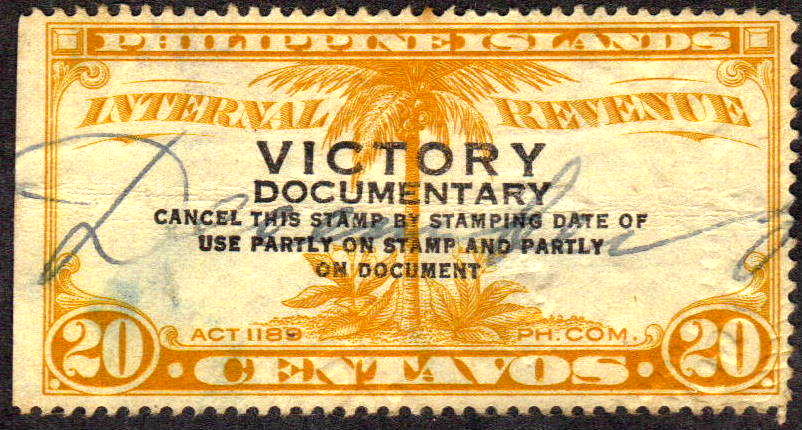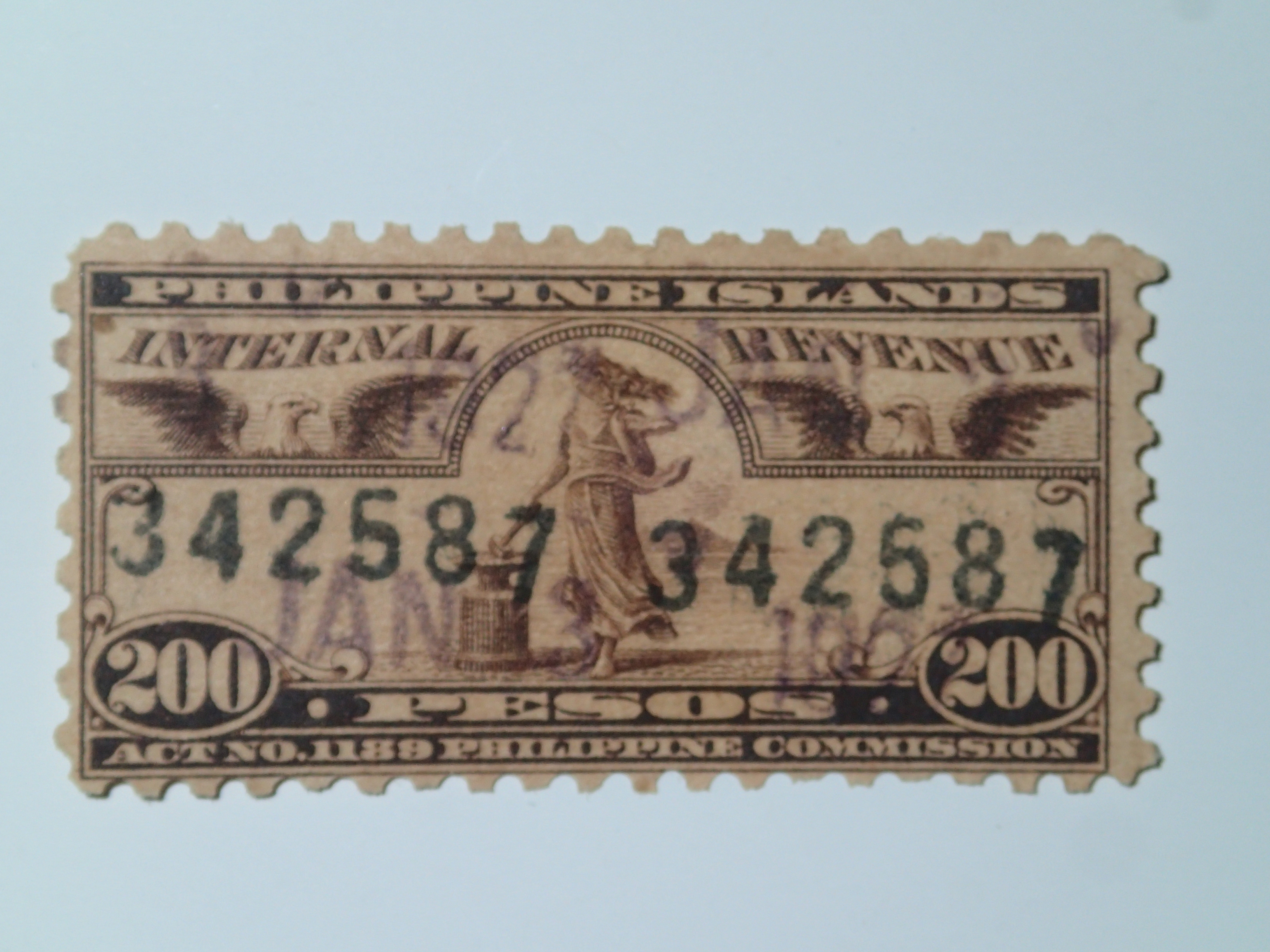Revenue stamps of the Philippines on:
[Wikipedia]
[Google]
[Amazon]

 Governing authorities in the Philippines have issued a variety of stamps for internal revenue taxes and other fiscal taxes since 1856. Forbin, Alfred. (1915) ''Catalogue de timbres-fiscaux''. Amiens: Yvert & Tellier, p. 347. Prior to 1856, internal revenues were collected via
Governing authorities in the Philippines have issued a variety of stamps for internal revenue taxes and other fiscal taxes since 1856. Forbin, Alfred. (1915) ''Catalogue de timbres-fiscaux''. Amiens: Yvert & Tellier, p. 347. Prior to 1856, internal revenues were collected via
 The Spanish government of the Philippines as part of the Spanish East Indies issued revenue stamps from 1856 until 1898. Revenues were issued for judicial fees, signature Fees, drafts, passports, surtax on poll receipts, receipts and accounts, transfer of livestock and surtax on consumption. Denominations ranged from 1/2 real to 20
The Spanish government of the Philippines as part of the Spanish East Indies issued revenue stamps from 1856 until 1898. Revenues were issued for judicial fees, signature Fees, drafts, passports, surtax on poll receipts, receipts and accounts, transfer of livestock and surtax on consumption. Denominations ranged from 1/2 real to 20
 The First Philippine Republic was established when
The First Philippine Republic was established when
 The U.S. established a military government in Manila in August 1898 during the Spanish–American War. It allowed the use of Spanish government revenues for fiscal purposes until their supply was exhausted in 1904. By this time, the United States had established a civilian administration called the Insular Government (1901–1935). This was a territorial government for the Philippine Islands. The first U.S. issues were printed in Manila in 1900 using the same designs as the Spanish issues with the exception that they were inscribed "United States Internal Revenue in the Philippine Islands". The Internal Revenue Law of 1904 provided for general internal revenue taxes, documentary taxes and transfer of livestock. A wide variety of issues exist in denominations ranging from one centavo to 20,000 pesos. Revenues issued from 1905 until 1935 were engraved and printed by the U.S. Bureau of Printing and Engraving in Washington, D.C.
The U.S. established a military government in Manila in August 1898 during the Spanish–American War. It allowed the use of Spanish government revenues for fiscal purposes until their supply was exhausted in 1904. By this time, the United States had established a civilian administration called the Insular Government (1901–1935). This was a territorial government for the Philippine Islands. The first U.S. issues were printed in Manila in 1900 using the same designs as the Spanish issues with the exception that they were inscribed "United States Internal Revenue in the Philippine Islands". The Internal Revenue Law of 1904 provided for general internal revenue taxes, documentary taxes and transfer of livestock. A wide variety of issues exist in denominations ranging from one centavo to 20,000 pesos. Revenues issued from 1905 until 1935 were engraved and printed by the U.S. Bureau of Printing and Engraving in Washington, D.C.
 The Commonwealth of the Philippines was officially restored in October 1944 when General
The Commonwealth of the Philippines was officially restored in October 1944 when General
A Catalog of Philippine Papeles Sellados 1700–1899 by Douglas K. Lehmann, Draft 2004 (with minor corrections 2010)
Fiscal Stamps of the Philippines: Handbook-Catalogue, 1856 to Date By Arnold H. Warren, A. P. S., compiled from 10 issues of ''The American Philatelist'', Oct 1967 to Jul 1968.Archived here.
*
The postage stamps of the Philippines, including a list of telegraph and revenue stamps issued under Spanish dominion (1904)
* The revenue stamps of the Philippines (Spanish period, U.S. period, and some post-independence), are listed under the Philippines section of this book, pages 209/237.
{{Portal bar, Asia, Philately, Philippines Philately of the Philippines Economy of the Philippines Philippines
stamped paper
Stamped paper is an often- foolscap piece of paper which bears a pre-printed revenue stamp. Mackay, James. ''Philatelic Terms Illustrated''. 4th edition. London: Stanley Gibbons, 2003, p. 147. Stamped papers are not a form of postal stationery ...
. Revenue stamps for the Philippines were issued by the Spanish East Indies government (1856–1898), the revolutionary government of the First Philippine Republic (1898–1901), the Insular Government of the United States (1901–1935), the government of the Commonwealth of the Philippines
The Commonwealth of the Philippines ( es, Commonwealth de Filipinas or ; tl, Komonwelt ng Pilipinas) was the administrative body that governed the Philippines from 1935 to 1946, aside from a period of exile in the Second World War from 1942 ...
(1935–42, 1945–46), the Philippine Executive Commission (1942–44) and the Republic of the Philippines (1946–present).
Issuing authorities
Spanish East Indies
pesos
The peso is the monetary unit of several countries in the Americas, and the Philippines. Originating in the Spanish Empire, the word translates to "weight". In most countries the peso uses the same sign, "$", as many currencies named "dollar" ...
. Original issues were printed in Spain. Provisional issues were overprinted in the Philippines.
First Republic
Emilio Aguinaldo
Emilio Aguinaldo y Famy (: March 22, 1869February 6, 1964) was a Filipino revolutionary, statesman, and military leader who is the youngest president of the Philippines (1899–1901) and is recognized as the first president of the Philippine ...
and his forces revolted against Spanish rule in 1898. The republic was short lived as a result of the Spanish–American War which gave control of the Philippines to the United States. After a short conflict with the U.S. Aguinaldo surrendered to U.S. forces in 1901. During the First Philippine Republic, revenues were issued in 1898-99 for insurance policies, receipts, and transfer of livestock.
Insular Government
Commonwealth
In 1935, the United States passed legislation granting the Philippines their independence and outlined a period of ten years for full independence from the U.S. During this period, 1935–1946, the Philippines was known as theCommonwealth of the Philippines
The Commonwealth of the Philippines ( es, Commonwealth de Filipinas or ; tl, Komonwelt ng Pilipinas) was the administrative body that governed the Philippines from 1935 to 1946, aside from a period of exile in the Second World War from 1942 ...
and most internal matters were handled by a semi-autonomous Commonwealth government. Revenue stamps used during the territorial period remained in use until the Japanese occupied the islands in 1942. Cattle registration revenue stamped documents which had been in use since 1906 and inscribed "Government of the Philippine Islands" were eventually reprinted in 1936 with the inscription: "Commonwealth of the Philippines".
Philippine Executive Commission
In January 1942, shortly after the occupation of Manila, Japanese authorities established the Philippine Executive Commission as the provisional government of the Philippines under Japanese Occupation. The commission used existing supplies of revenue stamps until their exhaustion in 1944. A new issue using the previous 1934 designs was printed in Manila in 1944 and inscribed "Republic of the Philippines". When cattle registration revenue stamped documents inscribed "Commonwealth of the Philippines" were exhausted, the commission printed new documents in Manila inscribed "Philippine Executive Commission". These cattle registrations are the only Philippine revenues so inscribed. They are unique in another way as well. During the Insular and Commonwealth government periods, cattle registration documents were bi-lingual in English and Spanish. When the Philippine Executive Commission documents were printed, they were in English andTagalog
Tagalog may refer to:
Language
* Tagalog language, a language spoken in the Philippines
** Old Tagalog, an archaic form of the language
** Batangas Tagalog, a dialect of the language
* Tagalog script, the writing system historically used for Tagal ...
(the native language of the Philippines) as a statement against Spanish colonialism. After the war, the Republic of the Philippines issued new cattle registrations inscribed "Republic of the Philippines" and reverted to English and Spanish text.
Republic of the Philippines
 The Commonwealth of the Philippines was officially restored in October 1944 when General
The Commonwealth of the Philippines was officially restored in October 1944 when General Douglas MacArthur
Douglas MacArthur (26 January 18805 April 1964) was an American military leader who served as General of the Army for the United States, as well as a field marshal to the Philippine Army. He had served with distinction in World War I, was C ...
landed at Leyte with U.S. forces. Although the Japanese Occupation didn't end until the surrender of Japan in September 1945, the Commonwealth government retained administration of the islands until July 4, 1946, when the U.S. officially granted full sovereignty and independence to the Philippines. Many of the pre-war revenues where reissued with a "Victory" overprint. After independence, the Republic of the Philippines began issuing revenue stamps inscribed "Republic of the Philippines" and of new designs.
See also
*Postage stamps and postal history of the Philippines
This is a survey of the postage stamps and postal history of the Philippines.
History
Origin
In 1767, the first post office was established in Manila, which was later organized as a postal district of Spain, encompassing Manila and the Phili ...
References
Further reading
A Catalog of Philippine Papeles Sellados 1700–1899 by Douglas K. Lehmann, Draft 2004 (with minor corrections 2010)
Fiscal Stamps of the Philippines: Handbook-Catalogue, 1856 to Date By Arnold H. Warren, A. P. S., compiled from 10 issues of ''The American Philatelist'', Oct 1967 to Jul 1968.
*
The postage stamps of the Philippines, including a list of telegraph and revenue stamps issued under Spanish dominion (1904)
* The revenue stamps of the Philippines (Spanish period, U.S. period, and some post-independence), are listed under the Philippines section of this book, pages 209/237.
External links
{{Portal bar, Asia, Philately, Philippines Philately of the Philippines Economy of the Philippines Philippines